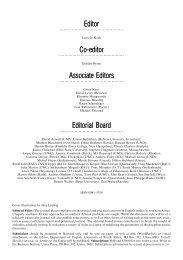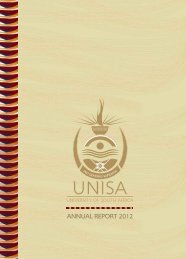pdf: 6.426kb - University of South Africa
pdf: 6.426kb - University of South Africa
pdf: 6.426kb - University of South Africa
You also want an ePaper? Increase the reach of your titles
YUMPU automatically turns print PDFs into web optimized ePapers that Google loves.
(which are strictly shamanic in character: magical<br />
flight, swallowing hot coals, and such) (Eliade<br />
1989:323±324).<br />
However, it is rather to his ecstatic capacities than<br />
to his exploits as a magician that the <strong>South</strong> American<br />
shaman owes his magico-religious position and his<br />
social authority. For his ecstatic capacities enable him,<br />
in addition to his usual prerogative <strong>of</strong> healing, to make<br />
mystical journeys to the sky to meet the gods directly<br />
and convey men's prayers to them (Eliade 1989:324).<br />
As in Mexico, shamanism in <strong>South</strong> America tends to<br />
be psychedelic, making frequent use <strong>of</strong> tropical plants<br />
which contain hallucinogenic alkaloids. Banisteriopsis<br />
spp. vine is widely utilized by <strong>South</strong> American<br />
shamans in the forests <strong>of</strong> the Upper Amazon, for the<br />
visions it produces are believed to represent encounters<br />
with supernatural forces (Drury 1982:16±17).<br />
As everywhere else, the essential and strictly<br />
personal function <strong>of</strong> the <strong>South</strong> American shaman<br />
remains healing. It is not always wholly magical in<br />
character. The <strong>South</strong> American shaman knows the<br />
medicinal virtues <strong>of</strong> plants and animals, employs<br />
massage, and so on. But since, in his view, the vast<br />
majority <strong>of</strong> illnesses have a spiritual cause Ð that is,<br />
involve either the flight <strong>of</strong> the soul or a magical object<br />
introduced into the body by spirits or sorcerers Ð he<br />
is obliged to have recourse to shamanic healing<br />
(Eliade 1989:326±327).<br />
The conception <strong>of</strong> disease as a loss <strong>of</strong> the soul,<br />
either strayed away or abducted by a spirit or a ghost,<br />
is extremely widespread in the Amazonian and<br />
Andean regions, but appears to be rather rare in<br />
tropical <strong>South</strong> America. When a soul carried <strong>of</strong>f by<br />
spirits or the dead is sought, the shaman is believed to<br />
leave his body and enter the underworld or the regions<br />
inhabited by the abductor (Eliade 1989:327).<br />
The shaman's ecstatic journey is generally indispensable,<br />
even if the illness is not due to the theft <strong>of</strong><br />
the soul by demons or ghosts. The shamanic trance<br />
forms part <strong>of</strong> the cure; whatever interpretation the<br />
shaman puts on it, it is always by his ecstasy that he<br />
finds the exact cause <strong>of</strong> the illness and learns the best<br />
treatment (Eliade 1989:328).<br />
The morphology <strong>of</strong> shamanic cures is almost the<br />
same throughout <strong>South</strong> America. It includes fumigations<br />
with tobacco, songs, massage <strong>of</strong> the affected<br />
area <strong>of</strong> the body, identification <strong>of</strong> the cause <strong>of</strong> the<br />
illness by the aid <strong>of</strong> the helping spirits (at this point<br />
comes the shaman's `trance', during which the<br />
audience sometimes ask him questions not directly<br />
connected with illness), and, finally, extractions <strong>of</strong> the<br />
pathogenic object by suction (Eliade 1989:329).<br />
<strong>South</strong> American shamanism still displays a number<br />
<strong>of</strong> extremely archaic characteristics: initiation through<br />
which ritual death and resurrection <strong>of</strong> the candidate is<br />
enacted, insertion <strong>of</strong> magical substances into his<br />
body, celestial ascent to lay the wishes <strong>of</strong> the whole<br />
society before the supreme god, shamanic healing by<br />
suction or search for the patient's soul, the shaman's<br />
ecstatic journey as psychopomp, the `secret songs'<br />
revealed by God or by animals, more especially birds<br />
(Eliade 1989:331±332).<br />
According to Joralemon (1993:4), the curanderos<br />
<strong>of</strong> Peru are now referred to as shamans, because their<br />
vocation fits well with classical definitions <strong>of</strong> shamanic<br />
healers as religious specialists who undergo<br />
controlled trances in a community context. Mestizo<br />
shamanism is a direct continuation <strong>of</strong> shamanism as it<br />
is found among ethnic groups. It is still an integral part<br />
<strong>of</strong> peasant religion (Luna 1986:31).<br />
Mestizo shamans are called vegetalistas. The term<br />
would mean, to any person not familiar with the belief<br />
system <strong>of</strong> these practitioners, an `expert in the use <strong>of</strong><br />
plants' (vegetales). This term indicates, however, not<br />
so much the fact that they frequently use plants in<br />
their practice, but refers to the origin <strong>of</strong> their knowledge:<br />
it comes from the spirit <strong>of</strong> certain plants<br />
(vegetales), which are the shaman's real teachers<br />
(Luna 1986:14±15). As already mentioned, shamanism<br />
in <strong>South</strong> America tends to be psychedelic.<br />
Vitebsky (1995:49), mentions in this regard that<br />
mestizo shamans are called vegetalistas because <strong>of</strong><br />
their skill with hallucinogenic plants.<br />
The term vegetalista should not be confused with<br />
that <strong>of</strong> herbalist, which denotes a person knowledge<br />
in the use <strong>of</strong> medicinal plants. All vegetalistas are<br />
usually also herbalists, in that they know a great deal<br />
about medicinal plants and frequently use them. But<br />
not all herbalists may be called vegetalistas (Luna<br />
1986:15). Wolf (1991:103) points out that vegetalistas<br />
are also versed in the use <strong>of</strong> medicinal herbs and<br />
plants, but herbalists do not use the psychotropic<br />
plants, nor do they learn from the plant by consuming<br />
the plant during rigorous dietary deprivation.<br />
Vegetalismo and Vegetalistas<br />
A vegetalista is a person who has acquired his<br />
knowledge from a plant, usually referred to as his<br />
doctores, and who uses this plant in his diagnosis and<br />
sometimes also in his healing <strong>of</strong> patients. Many <strong>of</strong><br />
these plants are hallucinogenic. Most vegetalistas<br />
have in common the use <strong>of</strong> tobacco (also a<br />
hallucinogenic) and ayahuasca, with the purpose <strong>of</strong><br />
diagnosing and/or curing illnesses, or <strong>of</strong> performing<br />
other shamanic tasks such as communicating with the<br />
spirits <strong>of</strong> plants, animals and human beings (dead or<br />
alive), travelling to distant places, finding lost objects,<br />
divining, and so forth (Luna 1986:16).<br />
When asked why they consume plant-teachers,<br />
vegetalistas say that they do it to `cure' themselves<br />
(curarse). This implies that they consume plantteachers<br />
not only to heal themselves <strong>of</strong> illness or to<br />
recover the energies <strong>of</strong> their youth, but also to<br />
`awaken' their minds (McKenna 1995:354).<br />
ISSN 0256±6060±Unisa Lat. Am. Rep. 16(2) 2000 49

















